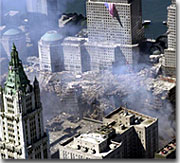
INSIDE
- Articles
- Book Reviews
- Movie Reviews
- Letters
- Thought for the Day
- Today's News
- Bookmarks
- Sponsors
- Submissions
- Fisher House Publishers
- About Living Better

Enter for a free trip to Tahiti
| A
72-hour emergency kit can mean the difference between disaster or
discomfort
The terrorist attack on September 11,
2001 and a recent power blackout in the eastern United States and
Canada have
brought the need for preparedness to the forefront. Disaster and tragedy can strike anywhere
and anyone. This past summer a heat wave in Europe killed many
people. A few years ago an ice storm in Montreal closed down the
city for weeks. A tornado in the U.S. midwest killed 19 and
destroyed
many homes. Floods, even sewer backups, can be devastating for
individual families. Whether the disaster is manmade or
natural it is important that we be prepared. Forest fires in
British Columbia (Canada) this summer caused the evacuation of
thousands of people, who left all their worldy goods as they locked
their doors. Those who were prepared were better off than the
others who depended on families and the community. One suggestion for preparedness is to
have a 72-hour emergency kit that is portable. The kit includes water
and food, clothing, and medical supplies for your size of family. A
72-hour emergency kit can mean the difference between disaster and and
slight discomfort for your family. The Davis School District in Farmington,
Utah suggests that the kit be tailored to meet the needs of your
family. "Pack hobby and entertainment items that appeal to your
family. Use foods that your family will eat. Include any special
medications that [are] required by family members." The kit should be put in a large
container and located near an exit so that it is readily available in
an emergency. Larger families can use a 32-gallon garbage
can. Other families may be able to use the plastic 5-gallon
bucket that is recommended for sanitation. You may choose to use
backpacks, one for each family member to carry when you leave the home. You also should have your car prepared.
Keep the gas tank above half full. Have a standard first aid kit,
blankets, a tent, flashlights and batteries, a change of clothes, extra
shoes and food and water in your car. If you are traveling in the
winter carry a candle and matches for warmth. These items would
be helpful if you were stranded while traveling. An article (http://www.beprepared.com/Articles/check.htm)
on emergency essentials
suggests that you consider the needs of elderly people as well as those
with special needs. For babies, you may need to store diapers,
wipes, ointment, bottles, etc. The article also recommends you enclose
clothing, matches, personal documents, and other items that could be
damaged in plastic. The kit should be checked twice a year and items
that expire should be replaced. Here is a modification of the list
prepared by the Davis School District.
Sanitation
Food (that doesn't spoil)
Standard first aid kit, including the
following:
Families should have an emergency plan
in place. Know where you are going in case of a disaster.
Phone family members to assure them that you are safe. Keep in
contact with neighbors and members of your church or other
groups. An emergency could mean you use
your kit in your home or that you live outside or in your car. Consider the kinds of emergencies you might have and develop
plans for each. These few suggestions could make the
difference between diaster, even death, and a little discomfort. Links: October 2003 |